ECON6000 Economic Principles and Decision Making - Assessment 2
VerifiedAdded on 2023/06/04
|7
|902
|108
Homework Assignment
AI Summary
This assignment solution focuses on applying economic principles to decision-making, specifically within a business context. It addresses two main problems. Problem A involves analyzing a production possibility frontier (PPF) for Schmeckt Gut, examining the impact of increased demand and strategies to meet it, such as exploring new resources, improving production technology, or specializing inputs. Problem B delves into market equilibrium, determining the equilibrium price and quantity for energy bars using given demand and supply functions. It further analyzes the effect of a price increase on demand and supply, illustrating the laws of demand and supply. The solution uses calculations and explanations to demonstrate these economic concepts. Desklib offers a variety of similar solved assignments and study resources for students.
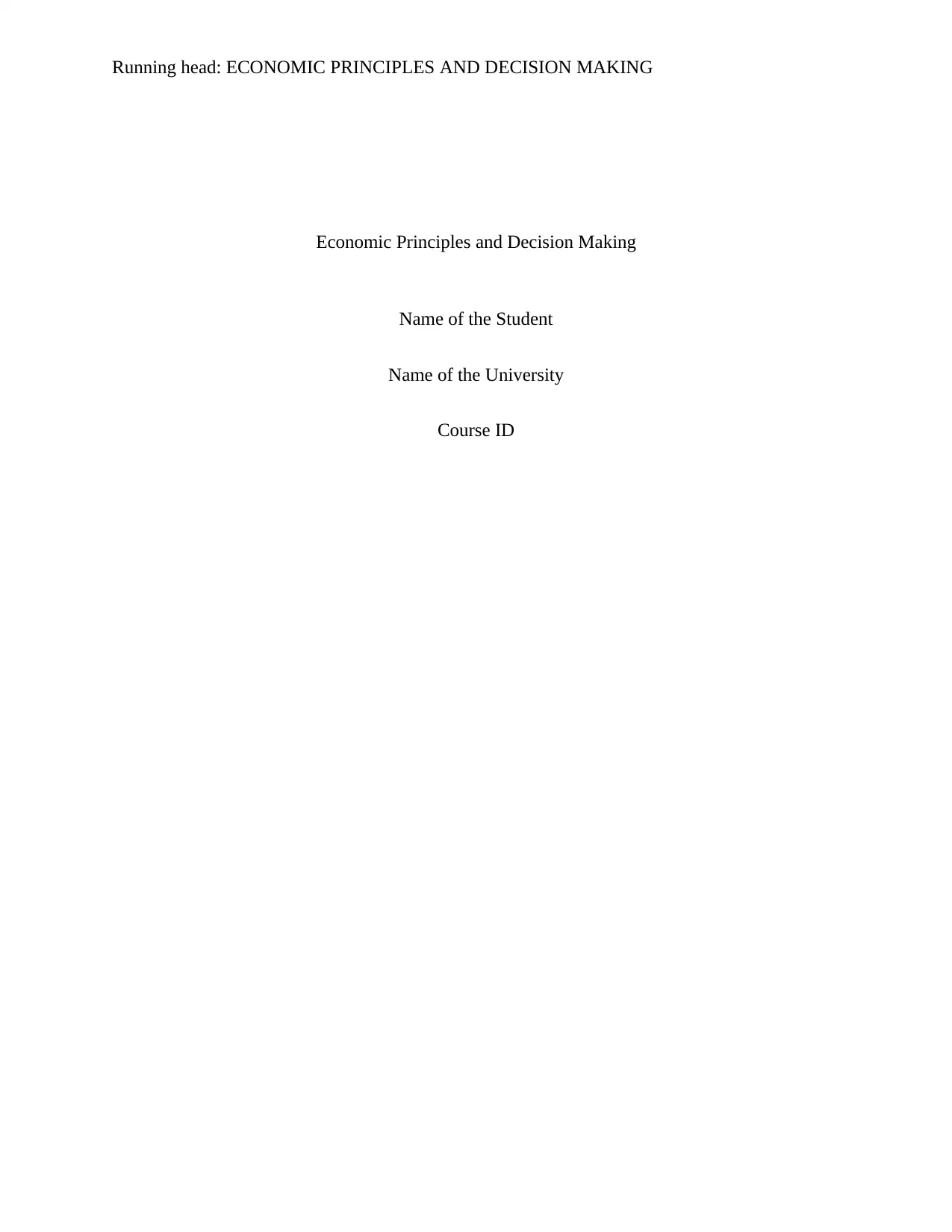
Running head: ECONOMIC PRINCIPLES AND DECISION MAKING
Economic Principles and Decision Making
Name of the Student
Name of the University
Course ID
Economic Principles and Decision Making
Name of the Student
Name of the University
Course ID
Paraphrase This Document
Need a fresh take? Get an instant paraphrase of this document with our AI Paraphraser
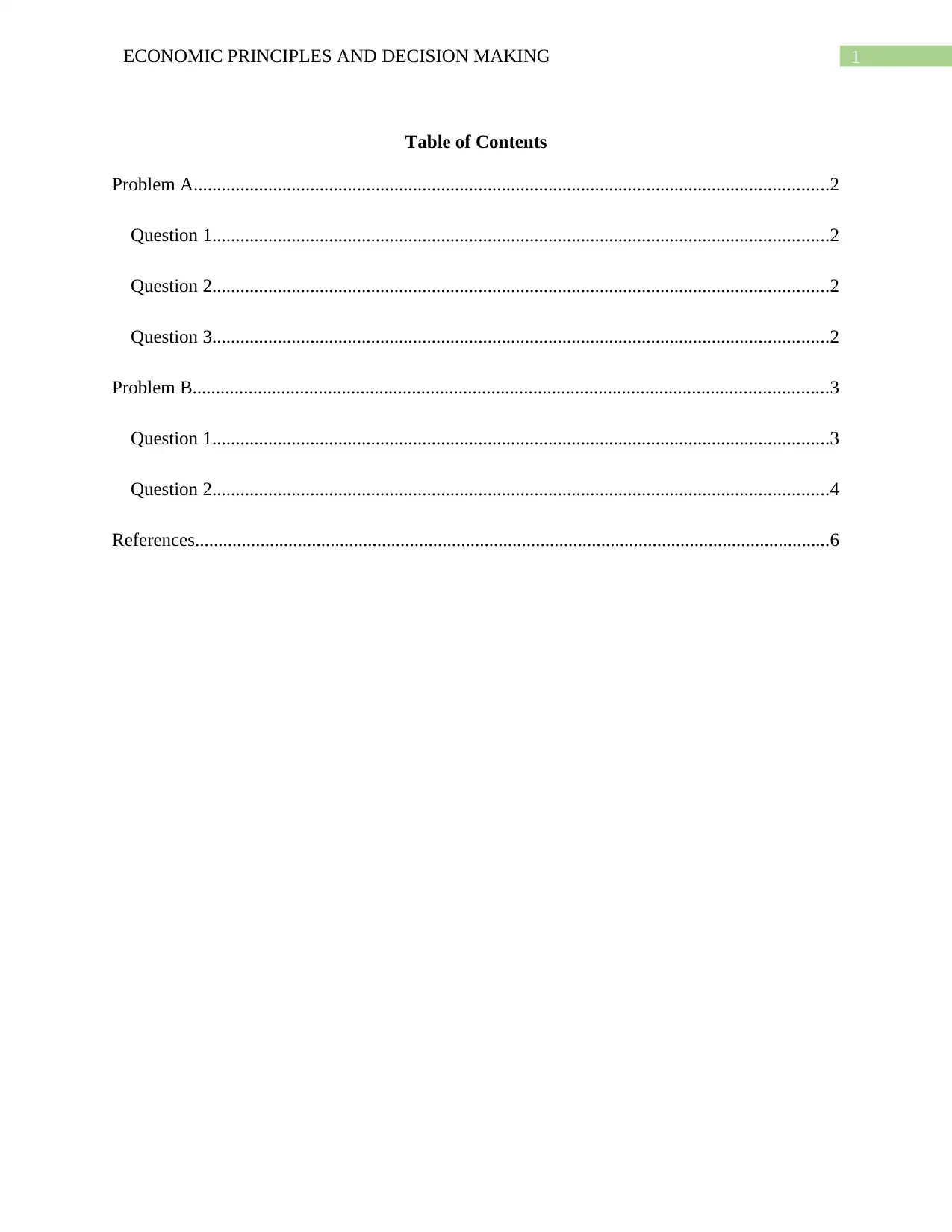
1ECONOMIC PRINCIPLES AND DECISION MAKING
Table of Contents
Problem A........................................................................................................................................2
Question 1....................................................................................................................................2
Question 2....................................................................................................................................2
Question 3....................................................................................................................................2
Problem B........................................................................................................................................3
Question 1....................................................................................................................................3
Question 2....................................................................................................................................4
References........................................................................................................................................6
Table of Contents
Problem A........................................................................................................................................2
Question 1....................................................................................................................................2
Question 2....................................................................................................................................2
Question 3....................................................................................................................................2
Problem B........................................................................................................................................3
Question 1....................................................................................................................................3
Question 2....................................................................................................................................4
References........................................................................................................................................6
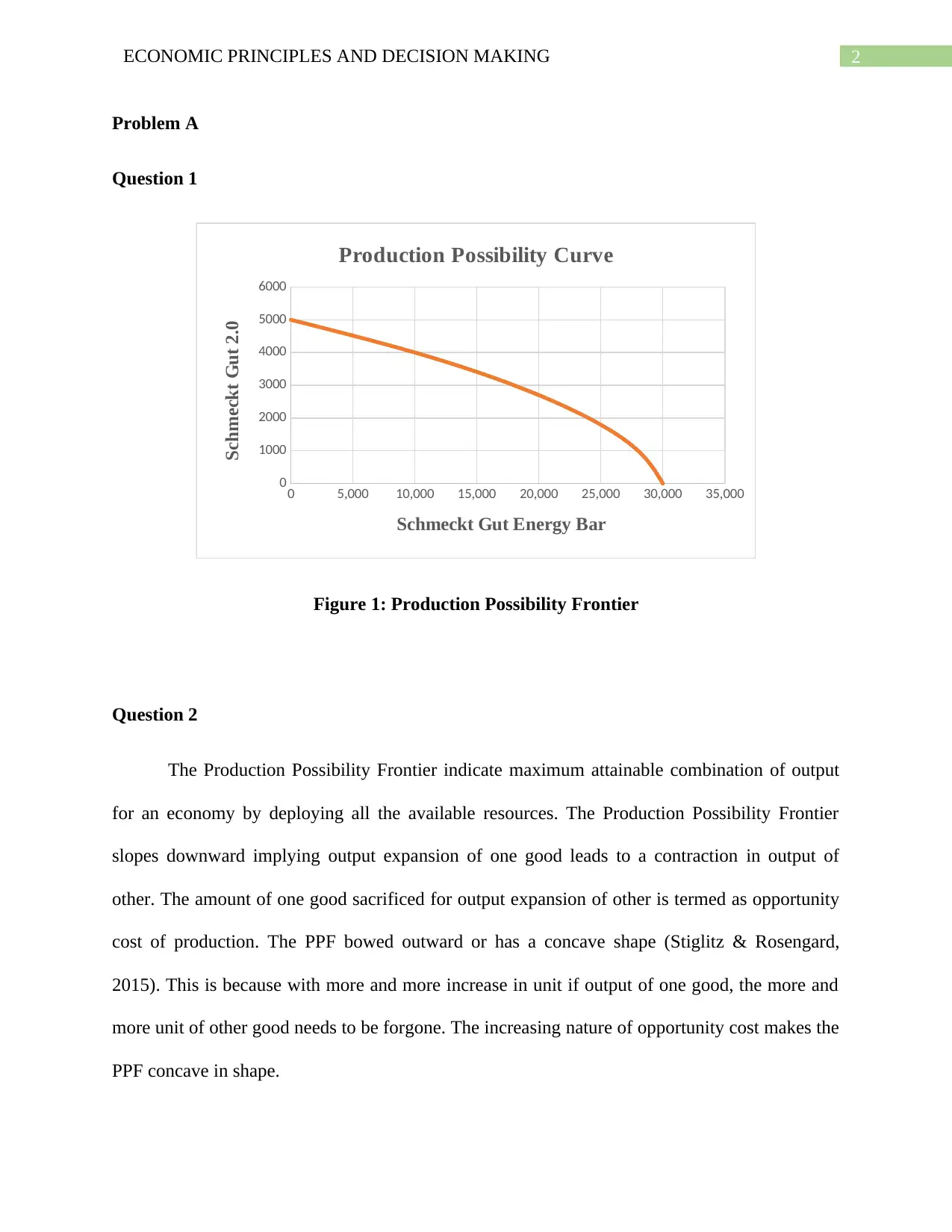
2ECONOMIC PRINCIPLES AND DECISION MAKING
Problem A
Question 1
0 5,000 10,000 15,000 20,000 25,000 30,000 35,000
0
1000
2000
3000
4000
5000
6000
Production Possibility Curve
Schmeckt Gut Energy Bar
Schmeckt Gut 2.0
Figure 1: Production Possibility Frontier
Question 2
The Production Possibility Frontier indicate maximum attainable combination of output
for an economy by deploying all the available resources. The Production Possibility Frontier
slopes downward implying output expansion of one good leads to a contraction in output of
other. The amount of one good sacrificed for output expansion of other is termed as opportunity
cost of production. The PPF bowed outward or has a concave shape (Stiglitz & Rosengard,
2015). This is because with more and more increase in unit if output of one good, the more and
more unit of other good needs to be forgone. The increasing nature of opportunity cost makes the
PPF concave in shape.
Problem A
Question 1
0 5,000 10,000 15,000 20,000 25,000 30,000 35,000
0
1000
2000
3000
4000
5000
6000
Production Possibility Curve
Schmeckt Gut Energy Bar
Schmeckt Gut 2.0
Figure 1: Production Possibility Frontier
Question 2
The Production Possibility Frontier indicate maximum attainable combination of output
for an economy by deploying all the available resources. The Production Possibility Frontier
slopes downward implying output expansion of one good leads to a contraction in output of
other. The amount of one good sacrificed for output expansion of other is termed as opportunity
cost of production. The PPF bowed outward or has a concave shape (Stiglitz & Rosengard,
2015). This is because with more and more increase in unit if output of one good, the more and
more unit of other good needs to be forgone. The increasing nature of opportunity cost makes the
PPF concave in shape.
⊘ This is a preview!⊘
Do you want full access?
Subscribe today to unlock all pages.

Trusted by 1+ million students worldwide
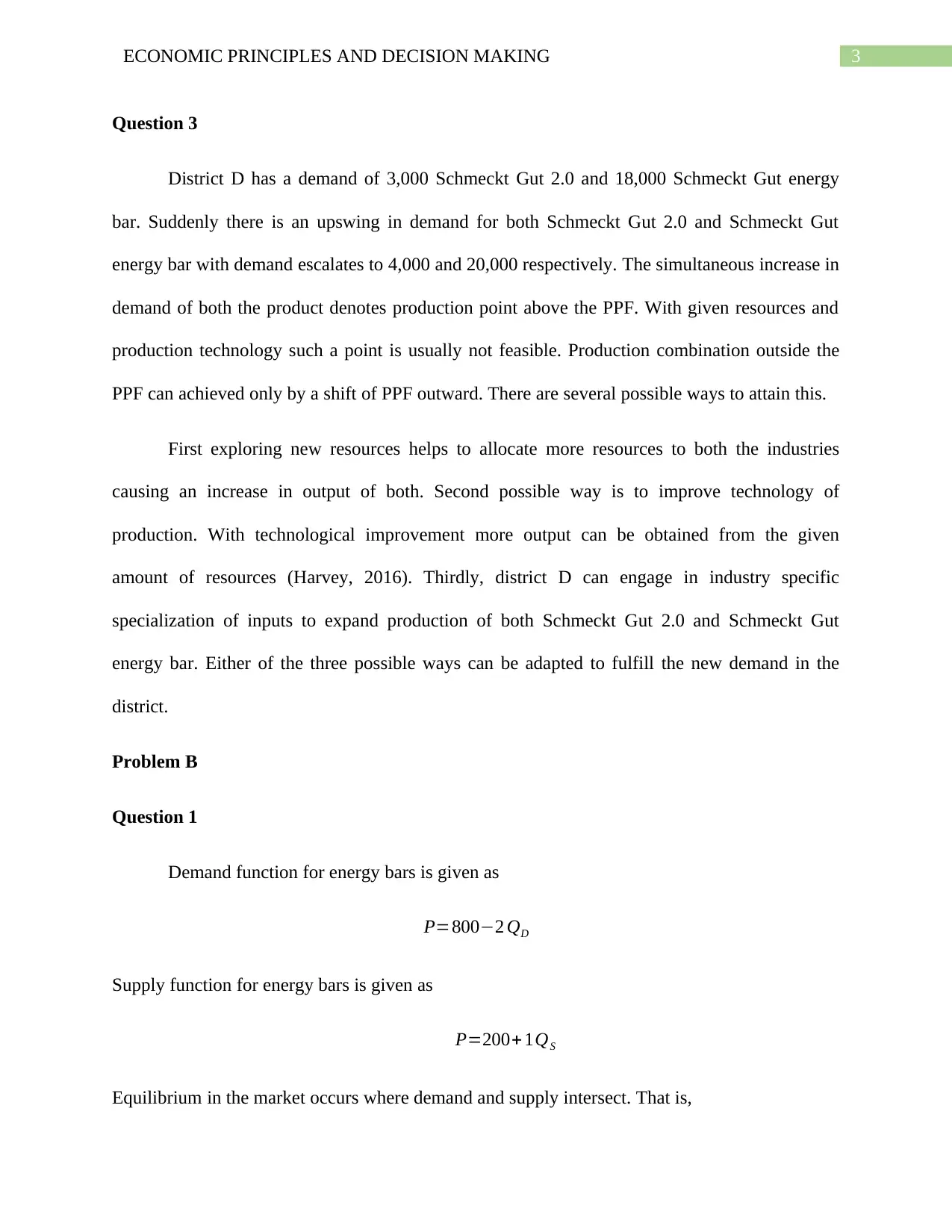
3ECONOMIC PRINCIPLES AND DECISION MAKING
Question 3
District D has a demand of 3,000 Schmeckt Gut 2.0 and 18,000 Schmeckt Gut energy
bar. Suddenly there is an upswing in demand for both Schmeckt Gut 2.0 and Schmeckt Gut
energy bar with demand escalates to 4,000 and 20,000 respectively. The simultaneous increase in
demand of both the product denotes production point above the PPF. With given resources and
production technology such a point is usually not feasible. Production combination outside the
PPF can achieved only by a shift of PPF outward. There are several possible ways to attain this.
First exploring new resources helps to allocate more resources to both the industries
causing an increase in output of both. Second possible way is to improve technology of
production. With technological improvement more output can be obtained from the given
amount of resources (Harvey, 2016). Thirdly, district D can engage in industry specific
specialization of inputs to expand production of both Schmeckt Gut 2.0 and Schmeckt Gut
energy bar. Either of the three possible ways can be adapted to fulfill the new demand in the
district.
Problem B
Question 1
Demand function for energy bars is given as
P=800−2 QD
Supply function for energy bars is given as
P=200+ 1QS
Equilibrium in the market occurs where demand and supply intersect. That is,
Question 3
District D has a demand of 3,000 Schmeckt Gut 2.0 and 18,000 Schmeckt Gut energy
bar. Suddenly there is an upswing in demand for both Schmeckt Gut 2.0 and Schmeckt Gut
energy bar with demand escalates to 4,000 and 20,000 respectively. The simultaneous increase in
demand of both the product denotes production point above the PPF. With given resources and
production technology such a point is usually not feasible. Production combination outside the
PPF can achieved only by a shift of PPF outward. There are several possible ways to attain this.
First exploring new resources helps to allocate more resources to both the industries
causing an increase in output of both. Second possible way is to improve technology of
production. With technological improvement more output can be obtained from the given
amount of resources (Harvey, 2016). Thirdly, district D can engage in industry specific
specialization of inputs to expand production of both Schmeckt Gut 2.0 and Schmeckt Gut
energy bar. Either of the three possible ways can be adapted to fulfill the new demand in the
district.
Problem B
Question 1
Demand function for energy bars is given as
P=800−2 QD
Supply function for energy bars is given as
P=200+ 1QS
Equilibrium in the market occurs where demand and supply intersect. That is,
Paraphrase This Document
Need a fresh take? Get an instant paraphrase of this document with our AI Paraphraser

4ECONOMIC PRINCIPLES AND DECISION MAKING
Demand for energy bars=Supply of energy bars
¿ , 800−2QD=¿ 200+1 QS
¿ , 3 Q=600
¿ , Q= 600
3
¿ , Q¿=200
Equilibrium price ( P¿ ) =800−2 QD
¿ 800− ( 2× 200 )
¿ 800−400
¿ 400
Equilibrium price of energy bars is obtained as $400
The equilibrium quantity of energy bar is 200
Question 2
If the subsequent price increases by $1, then following the increase in price new price of
energy bars would be ($400 + $1) = $401.
At the new price demand can be found using demand function.
QD= 800−P
2
¿ 800−401
2
Demand for energy bars=Supply of energy bars
¿ , 800−2QD=¿ 200+1 QS
¿ , 3 Q=600
¿ , Q= 600
3
¿ , Q¿=200
Equilibrium price ( P¿ ) =800−2 QD
¿ 800− ( 2× 200 )
¿ 800−400
¿ 400
Equilibrium price of energy bars is obtained as $400
The equilibrium quantity of energy bar is 200
Question 2
If the subsequent price increases by $1, then following the increase in price new price of
energy bars would be ($400 + $1) = $401.
At the new price demand can be found using demand function.
QD= 800−P
2
¿ 800−401
2
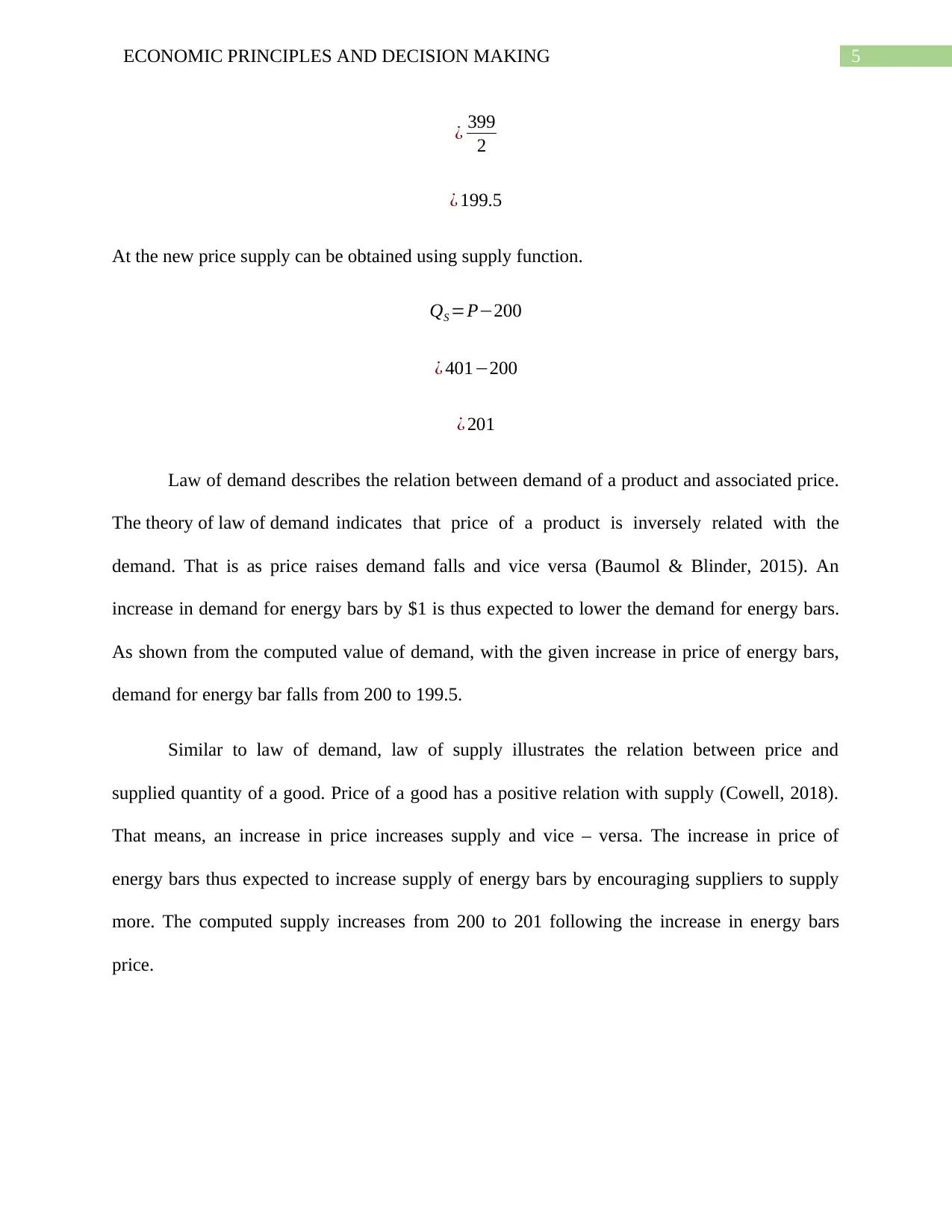
5ECONOMIC PRINCIPLES AND DECISION MAKING
¿ 399
2
¿ 199.5
At the new price supply can be obtained using supply function.
QS =P−200
¿ 401−200
¿ 201
Law of demand describes the relation between demand of a product and associated price.
The theory of law of demand indicates that price of a product is inversely related with the
demand. That is as price raises demand falls and vice versa (Baumol & Blinder, 2015). An
increase in demand for energy bars by $1 is thus expected to lower the demand for energy bars.
As shown from the computed value of demand, with the given increase in price of energy bars,
demand for energy bar falls from 200 to 199.5.
Similar to law of demand, law of supply illustrates the relation between price and
supplied quantity of a good. Price of a good has a positive relation with supply (Cowell, 2018).
That means, an increase in price increases supply and vice – versa. The increase in price of
energy bars thus expected to increase supply of energy bars by encouraging suppliers to supply
more. The computed supply increases from 200 to 201 following the increase in energy bars
price.
¿ 399
2
¿ 199.5
At the new price supply can be obtained using supply function.
QS =P−200
¿ 401−200
¿ 201
Law of demand describes the relation between demand of a product and associated price.
The theory of law of demand indicates that price of a product is inversely related with the
demand. That is as price raises demand falls and vice versa (Baumol & Blinder, 2015). An
increase in demand for energy bars by $1 is thus expected to lower the demand for energy bars.
As shown from the computed value of demand, with the given increase in price of energy bars,
demand for energy bar falls from 200 to 199.5.
Similar to law of demand, law of supply illustrates the relation between price and
supplied quantity of a good. Price of a good has a positive relation with supply (Cowell, 2018).
That means, an increase in price increases supply and vice – versa. The increase in price of
energy bars thus expected to increase supply of energy bars by encouraging suppliers to supply
more. The computed supply increases from 200 to 201 following the increase in energy bars
price.
⊘ This is a preview!⊘
Do you want full access?
Subscribe today to unlock all pages.

Trusted by 1+ million students worldwide
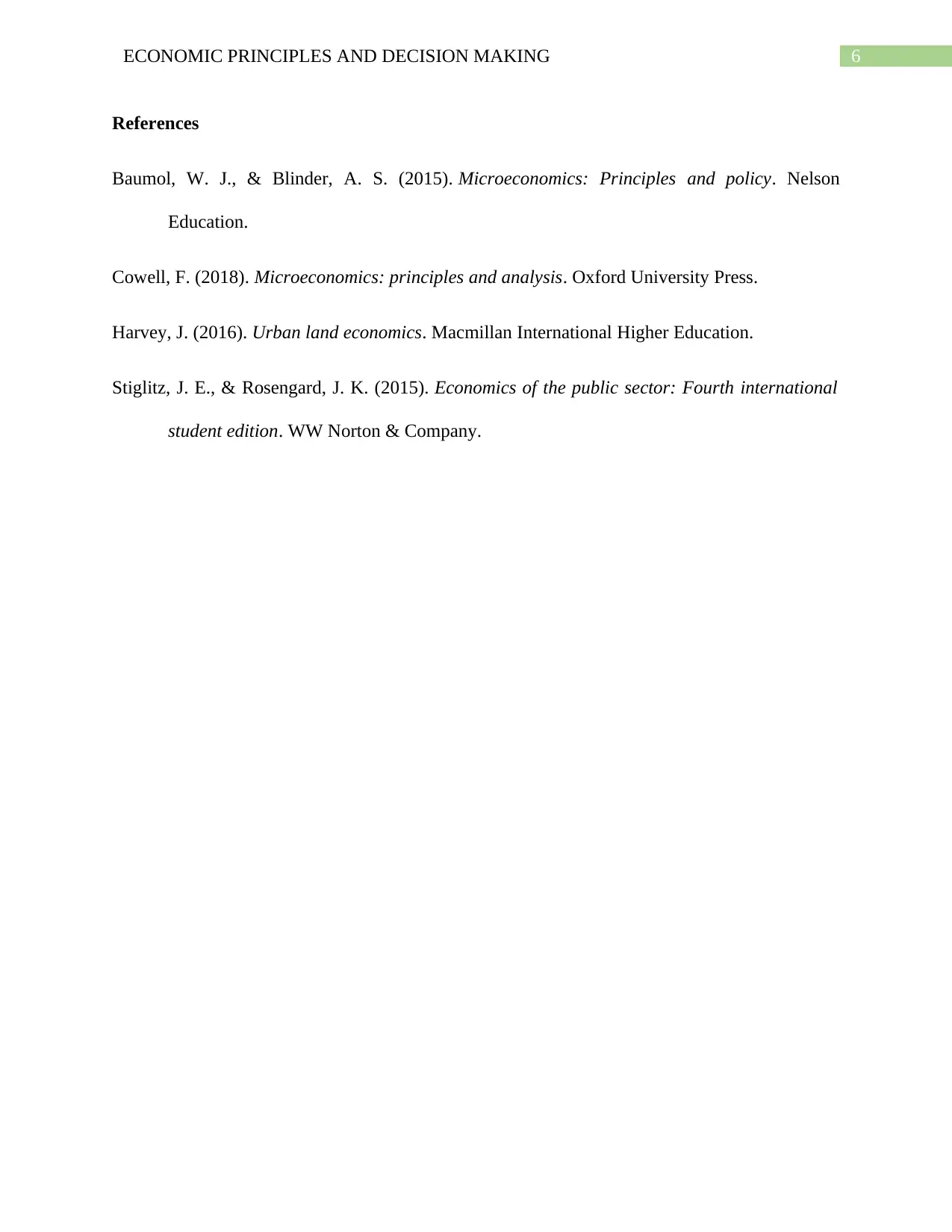
6ECONOMIC PRINCIPLES AND DECISION MAKING
References
Baumol, W. J., & Blinder, A. S. (2015). Microeconomics: Principles and policy. Nelson
Education.
Cowell, F. (2018). Microeconomics: principles and analysis. Oxford University Press.
Harvey, J. (2016). Urban land economics. Macmillan International Higher Education.
Stiglitz, J. E., & Rosengard, J. K. (2015). Economics of the public sector: Fourth international
student edition. WW Norton & Company.
References
Baumol, W. J., & Blinder, A. S. (2015). Microeconomics: Principles and policy. Nelson
Education.
Cowell, F. (2018). Microeconomics: principles and analysis. Oxford University Press.
Harvey, J. (2016). Urban land economics. Macmillan International Higher Education.
Stiglitz, J. E., & Rosengard, J. K. (2015). Economics of the public sector: Fourth international
student edition. WW Norton & Company.
1 out of 7
Related Documents
Your All-in-One AI-Powered Toolkit for Academic Success.
+13062052269
info@desklib.com
Available 24*7 on WhatsApp / Email
![[object Object]](/_next/static/media/star-bottom.7253800d.svg)
Unlock your academic potential
Copyright © 2020–2025 A2Z Services. All Rights Reserved. Developed and managed by ZUCOL.




